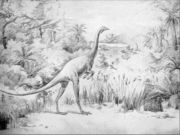Struthiomimus
2007 Schools Wikipedia Selection. Related subjects: Dinosaurs
| iStruthiomimus |
||||||||||||||||||
|---|---|---|---|---|---|---|---|---|---|---|---|---|---|---|---|---|---|---|
 Illustration of a Struthiomimus specimen.
|
||||||||||||||||||
| Scientific classification | ||||||||||||||||||
|
||||||||||||||||||
|
|
||||||||||||||||||
| Struthiomimus altus Osborn, 1917 |
Struthiomimus was a long-legged, ostrich-like dinosaur of the family ornithomimidae, which lived in the area that is now Alberta, Canada, during the late Cretaceous Period, approximately 75 million years ago. Its generic name is derived from the Greek στρουθιον/strouthion meaning 'ostrich' and μιμος/mimos meaning 'mimic' or 'imitator'. The specific name altus is from Latin, meaning 'lofty' or 'noble'.
The bipedal Struthiomimus stood about 3.7 meters long and 1.4 meters (4'6") tall at the hips and weighed around 150 kg (330 lb). Struthiomimus is one of the more common small dinosaurs in the Dinosaur Provincial Park; its abundance suggests that it was an herbivore or an omnivore rather than a carnivore.
Discovery and species
In 1901 Lawrence Lambe found some incomplete remains and named them Ornithomimus altus, placing them in the same genus as material earlier described by Marsh in 1890. However in 1914, a nearly complete skeleton (pictured above) was discovered by Barnum Brown, at the Red Deer River site in Alberta and officially described as the separate genus Struthiomimus by Henry Fairfield Osborn, in 1917. Of the specimens found in Alberta, some were found in and under piles of ash, suggesting a forest fire may have killed them.
Struthiomimus is also known from the Horseshoe Canyon Formation of Alberta and the Hell Creek Formation of Montana. These animals have not been thoroughly studied yet but they may represent new species of Struthiomimus.
Paleobiology
The legs (hind limbs) of Struthiomimus were long, powerful and seemingly well-suited to rapid running, much like an ostrich. The supposed speed of Struthiomimus was, in fact, its only defence from predators, such as the dromaeosaurs (e.g. Saurornitholestes and Dromaeosaurus) and the tyrannosaurs (e.g. Daspletosaurus and Gorgosaurus), which lived at the same time. It is estimated to have been able to run at speeds between 50 to 80 km/h (30 to 50 mph).
Its neck was slender and ended in a small, toothless, beaked skull, with relatively large eyes. The 'arms' of Struthiomimus were long and comparatively strong; the fore limbs were more powerful and the claws were more strongly hooked than in Ornithomimus. There are similarities to modern-day sloths. It also had the typical characteristics of most ornithomimids: a long, stiff tail and a toothless beak.
Diet
There has been much discussion about the feeding habits of Struthiomimus. Due to its straight-edged beak, Struthiomimus is thought most likely to have been either an omnivore or herbivore. Some theories suggest that it may have been a shore-dweller and may have eaten insects, crabs, shrimp and possibly eggs from other dinosaurs. Some paleontologists noted that it was more likely to be a carnivore given that it was nested within the likewise carnivorous theropod group. This theory has never been discounted but Osborn, who described and named the dinosaur, proposed that it probaby ate buds and shoots from trees, shrubs and other plants, using its forelimbs to grasp branches and its long neck to enable it accurately to select particular items.
It is possible that Struthiomimus had feathers, like many of its relatives.
Posture
Early restorations depict a posture reminiscent of the 'walking tripod' postures of Tyrannosaurus and Iguanodon, before the later more balanced depictions with stiffened horizontal tails and bodies were widely accepted. This newer view creates an image much more reminiscent of modern flightless birds, such as the ostrich to which this dinosaur's name refers.
Popular culture
The best-preserved skeleton of Struthiomimus is currently on display at the American Museum of Natural History, in Manhattan, New York, while the best-preserved skull is currently on display at the Royal Tyrrell Museum of Palaeontology, in Drumheller, Alberta, Canada.


